What to Know
- Gov. Andrew Cuomo is lifting all micro-cluster zone restrictions in the state except for five yellow precautionary areas (four in NYC, one in Newburgh) as the state climbs down from its holiday surge
- The number of tri-state confirmed U.K. variant cases is up to 58 (42 in NY, 8 in NJ, 8 in CT); NJ's patients range in age from 10 to 65 and include one death, though that person had underlying conditions
- Vaccines are the answers but supply has been a tri-state-wide issue; help is coming, with the Biden administration pledging to give states 16% more in weekly supply over each of the next three weeks
Gov. Andrew Cuomo has lifted micro-cluster zone restrictions for all of the state's 26 orange and yellow zones except for five, citing ongoing declines in positivity and hospitalization rates across the board. He is not tweaking New York City's indoor dining ban just yet, calling that an ongoing and "city-specific" issue.
But he did say he'll have a plan for the five boroughs' restaurants by the end of the week, Cuomo said. And he'll share it publicly, after discussing the data with top health and elected officials as well as key stakeholders.
"I fully understand how difficult it is that they're closed, not just for the restaurants but all the people who are employed there. On the flip side is how fast this virus can take off," Cuomo said. "But we'll have a plan by the end of the week."
Get Tri-state area news and weather forecasts to your inbox. Sign up for NBC New York newsletters.
Lifting most of state's color-coded micro-cluster zones, which apply varying rules to schools, businesses, mass gatherings and houses of worship based on risk and haven't been changed in more than a month, is a significant step forward.
“We’re talking about livelihoods and the economy and billions of dollars,” he said. “We make decisions based on the facts today ... The holiday surge came. The holiday surge is over. We’re not back to where we were but nobody’s back to where we were.”
Are you in a cluster zone? Here are the maps -- and a reminder of the rules
No red zones, which come with the strictest rules, have existed in months. A number of orange zones, including on Staten Island and in Westchester County, remained, prohibiting indoor dining and the operation of high-risk businesses as well as in-person learning for schools that don't exercise the test-out option.
In places where the orange zones were lifted, like Port Chester in Westchester County, restaurants are allowed to serve up to 50 percent capacity indoors. Houses of worship are also allowed 50 percent capacity, and up to 25 people can gather in public, indoors or out.
"When you keep restaurants open late, that tends to be more problematic, more groups tend to be drinking," Cuomo said.
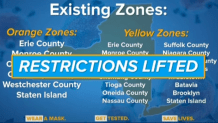
Four yellow zones, which are the most precautionary cluster zone designation, remain: two in the Bronx, where the governor has been particularly concerned about higher-than-average positivity rates, one in Washington Heights, another in Queens and one in Newburgh. Those zones still have the highest hospital admissions per capita in the state and week-over-week case growth, Cuomo sid.
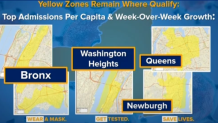
The governor first hinted at changes to come earlier this week when he said New York's rate of transmission had fallen below 1.0 for the first time since the latest surge. Cuomo said modeling projections indicate the transmission rate will stay below 1.0, assuming continued mitigation efforts and smart public behavior. Anything higher than 1.0 is considered an active outbreak, he says.
Not only is the state on the way down from the holiday spike, experts believe the downward trend is going to continue as far as positivity rates, Cuomo added.
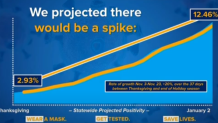
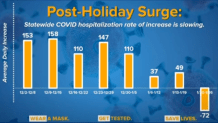
While the loosening of cluster zone rules is a significant sign of progress, Cuomo's promise to deliver a plan for New York City restaurants by the end of this week has far wider impact -- on both the economic and human scale. Restaurant sales nationally have fallen about $240 billion and 2.5 million jobs have been lost amid the pandemic, according to a new National Restaurant Association report.
The ongoing ban in the city, while regions with higher hospitalization and case rates have seen no interruption to indoor service since they were permitted to resume it, has drawn the ire of business owners, staff and industry representatives. It has also prompted a series of lawsuits against state and city.
"We don't have a plan today. I'm aware of the lawsuits. Everyone understands the concept of restrictions, just not how it applies to them," Cuomo said. "We are looking at going back to the 25 percent (capacity), the question is how and when you do that."
Indoor dining was suspended entirely across the five boroughs in mid-December, less than two months after it was first allowed to return with severe capacity restrictions. That order from Cuomo was born from his concerns over increased social activity during the holidays and the so-called "density problem" in the city. The same crowded energy that makes it one of the globe's most vibrant places also puts it at heightened risk of spreading infection, the governor says.
He didn't immediately give any indication Wednesday of where his thinking stood as far as a path forward for the city's restaurants. Cuomo's next briefing is scheduled for Friday, where that long-awaited plan will likely be announced.
Currently, restaurants across New York state are required to close at 10 p.m.; the New York State Restaurant Association wants Cuomo to extend the curfew to midnight, at least, and allow limited indoor dining in the five boroughs. Andrew Rigie, executive director of the NYC Hospitality Alliance, said it’s unfair that indoor dining is banned in the city while other parts of the state have higher infection rates.
Cuomo has been hesitant to relax restrictions in New York City particularly. It was the last of the state's 10 regions to see the governor's PAUSE order lifted last spring and it has endured a series of so-called "city-specific" limitations since.
The governor has repeatedly and insistently expressed his concern about the emergence of the U.K. variant, of which there are now 42 confirmed cases in nine New York counties, and other, more transmissible strains not yet identified locally, like the South African and Brazilian variants. He says those strains have only compounded the risk of spread for a city as magnetic and dense as New York -- and with the goal of herd immunity via vaccination likely still many months away.
If anything is going to overwhelm the hospital system now, Cuomo believes it will be a new, more contagious strain.
As it is, New York state and city are just beginning -- as in the last few days -- to see core COVID metrics begin to decline from the holiday peak. Daily case totals have gone down by a few thousand statewide, though remain relatively high compared with most of the fall. Hospitalizations, which increased following the case surge, have dropped back into the high 8,000s. Daily death tolls aren't rising beyond their one day above 200 earlier this month, but they haven't declined yet.
According to New York City data, total cases across the five boroughs are down 6 percent over the last seven days compared with the weekly average for the month prior, while hospitalization and death rates have stabilized. Statewide, new case averages over the last week are down 23 percent over the period two weeks prior, New York Times data shows. Hospitalizations and deaths are up 3 percent and 5 percent respectively, the Times says -- a much lower increase from recent weeks.
Cuomo remains concerned about higher positivity and hospitalization rates in three regions -- the Finger Lakes, which has been an issue for some time, Long Island and the Bronx. Apart from describing all three regions' numbers as "an issue" and saying the state would focus on those spots, he hasn't elaborated.


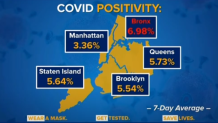
New York City Mayor Bill de Blasio has largely consistently supported Cuomo's varying city-specific restrictions for months now, most recently as they relate to the ban on indoor dining. He says he wants to infuse the economy and help struggling business owners as much as anyone, but notes public health requires officials to operate on meticulously analyzed scientific data and trends.
As recently as Tuesday, de Blasio said, "Right now, the data and the science tells us, 'Be careful.'"
In that vein, the mayor declined to commit Wednesday to a start date for the return of in-person schooling for middle and high school students. Those grades have been all remote since the city topped de Blasio's 3 percent rolling positivity rate threshold shortly before Thanksgiving. The mayor said he expects to provide additional guidance next month, though indicated in-person education in New York City for all age groups may not fully return until September.
Daily Percentage of Positive Tests by New York Region
Gov. Andrew Cuomo breaks the state into 10 regions for testing purposes and tracks positivity rates to identify potential hotspots. Here's the latest tracking data by region and for the five boroughs. For the latest county-level results statewide, click here
Source: ny.gov
COVID-19 Variants Raise Concern Amid Slow Vaccine Rollout
With the vaccine rollout in its relative infancy, tri-state officials are focused on containing spread from more contagious variants. As of the governors' latest respective reports, the tri-state area has confirmed at least 58 cases (42 in New York, eight in Connecticut, eight in New Jersey) of the U.K. strain.
Cuomo's count increased by nearly double Wednesday over his latest report, while New Jersey added six new cases -- four in Ocean, two in Essex and two in Morris counties. The Garden State's U.K. variant cases range in age from 10 to 65 and one person confirmed to have the strain has died. That individual had severe underlying conditions, Department of Health Commissioner Judy Persichilli said.
Only one of the eight known cases involved a person with a history of international travel, she added.
Of the multitude of variants that have emerged over the last year, Dr. Jay Varma, the mayor's senior advisor for public health, said Tuesday that the U.K., South African and Brazilian strains are most concerning, given their high level of infectiousness. Varma referenced preliminary data that appears to show the U.K. variant may also be more lethal, but stressed the need for more extensive study.
Daily Percentage of Positive Tests by New York Region
Gov. Andrew Cuomo breaks the state into 10 regions for testing purposes and tracks positivity rates to identify potential hotspots. Here's the latest tracking data by region and for the five boroughs. For the latest county-level results statewide, click here
Source: ny.gov
New federal flight restrictions went into effect this week to help limit travel-related spread, especially from places where the highly contagious strains have emerged.
Ultimately, tri-state officials say their hope is to slow the spread of infection enough to keep pace with the vaccination race, which they expect to ramp up soon. Cuomo, de Blasio and New Jersey Gov. Phil Murphy all say they believe the Biden administration will revolutionize the process. It's just going to take time.
More than 673,000 total doses have been administered in the city thus far, which is more than the population of Detroit and a 20,000-shot increase in one day. Statewide, 96 percent of all first doses have been delivered to date -- more than 1.2 million. Roughly 186,000 second dose shots have been administered as well.
New York City and New Jersey Vaccine Providers
Click on each provider to find more information on scheduling appointments for the COVID-19 Vaccine.
Data: City of New York, State of New Jersey • Nina Lin / NBC
While de Blasio has said reserved second dose shots should be opened up for first dose usage (by federal directive) amid current supply constraints, Cuomo says that could just create more issues. If the second shots are gone by the time people need them, that could just complicate the effort further, he said.
For his part, de Blasio says he'd rather have more people with some protection, which early evidence shows first doses provide to a degree, than fewer people with full protection. The city had been running low, with less than 8,000 first doses left on hand Tuesday, but new federal shipments Wednesday boosted supply. Right now, the city has about 82,500 first and nearly 285,000 second dose shots on hand. Nearly 75,000 second dose shot appointments have yet to be scheduled.
While desperately welcomed -- and needed -- this week's shipment will only allow the city to sustain a vaccination pace over the next week that the mayor says is well below the city's current and growing operational capacity. Help is coming.
When Could I Get the Vaccine?
Answer the questions to calculate your risk profile and see where you fall in your county's and state's vaccine lineup. This estimate is based on a combination of vaccine rollout recommendations from the CDC and the National Academies of Sciences, Engineering, and Medicine.
For a more detailed breakdown of who is included in each priority group, see this methodology.
Source: the Vaccine Allocation Planner for COVID-19 by Ariadne Labs and the Surgo Foundation
Interactive by Amy O’Kruk/NBC
The Biden administration has pledged to give states a roughly 16 percent boost in deliveries over the next three weeks, which Cuomo told MSNBC Wednesday would allow the state to extend its appointment-scheduling operations beyond the week-to-week scenario under which it has been operating. He also added that the increase "does not solve the fundamental anxiety which has been created here."
"President Biden is owning the mission and he is giving us clear, clear indications of where he is going and he wants to keep upping the bar, making this vaccination effort stronger and stronger all the time," de Blasio said Wednesday.
Moderna is increasing the city's weekly allotment by 17,000 doses next week, which the mayor called a welcomed shot in the arm. Still, he says it's not enough, and the governor said the very limited supply is causing people to travel great distance just to see if a shot is available.
"You have people chasing this vaccine from all over the state," Cuomo said. "You'll have people drive more than 100 miles to a site."
The governor also said that when the Yankee Stadium vaccine hub opens in the coming weeks, he'd like it to be reserved for Bronx residents. The mayor focused more on the hub at the Armory in Washington Heights, where he said the predominantly lower income residents of the neighborhood are getting left out. In response to the concern, New York-Presbyterian announced new guidelines would be implemented at the center, limiting the vaccines to New York City residents only, with 60 percent of appointments reserved for Upper Manhattan and South Bronx residents.
New Jersey, which typically receives less than half the weekly federal first dose allocation New York does, has also been confined by supply limits. As of Wednesday, the Garden State had administered a total of 642,613 shots, less than New York City, with the vast majority of those (86 percent) being first doses.
Tracking Coronavirus in Tri-State
For the first time, the number of total vaccine doses administered in New Jersey has exceeded the state's total number of confirmed COVID cases since March.
State health officials said Wednesday most people who have already received a first dose will automatically get their second dose appointment dates via email. If they don't, they should contact the sites where they got their first shots for details.
But that could be a problem for some, as the biggest vaccinator in the state shut down its appointment portal Wednesday. Hackensack Meridian is closed to new appointments after filling slots through Feb. 23.
"It's a logistical nightmare to be able to rejigger and to contact people and to eventually rebook," Hackensack Meridian President and CEO Bob Garrett exclusively told NBC New York. "We just don't want to disappoint people or really frustrate them."
Garrett did said he expects the appointments to continue once again sometime next week, and hopes to open more vaccination sites as well, at places like urgent care centers and doctors' offices.
At the only walk-up vaccination site in the state, the line started outside Paterson's International High School starting at 4 a.m. Another 469 doses were given out there, with the city's mayor wanting to do double that amount, but is limited by the supply.
Like Cuomo in New York, Murphy says New Jersey has the means to ramp up the pace of administration exponentially, with hundreds of providers in its network. All he needs are the doses, he says, and seems hopeful more could be coming on the horizon.
"It's not just going up from 105,000 doses to 130,000, at that point I think you're going to see going up up dramatically," Murphy said.
Earlier this week, the new head of the CDC couldn't answer as to when states would have the supply they say they need.
Meanwhile, three-times-weekly White House Coronavirus Task Force briefings, which ended in the midst of the pandemic under the Trump administration, resumed Wednesday at the White House. They feature familiar faces, including Dr. Anthony Fauci, as well as other top health officials.
According to the CDC, less than 54 percent of the 44 million-plus total doses distributed to states to date have been administered. Fewer than 20 million people have received at least one shot; about 3.5 million have gotten both.
The U.S. has now well surpassed 25 million confirmed coronavirus cases and seen more than 423,000 virus-related deaths since the onset of the pandemic more than a year ago, according to Johns Hopkins University. Federal officials said Wednesday the U.S. death toll could hit 512,000 before the end of February.
Globally, the number of COVID-19 cases topped 100 million Tuesday, the university said, while worldwide deaths have crossed the 2.1 million mark.



